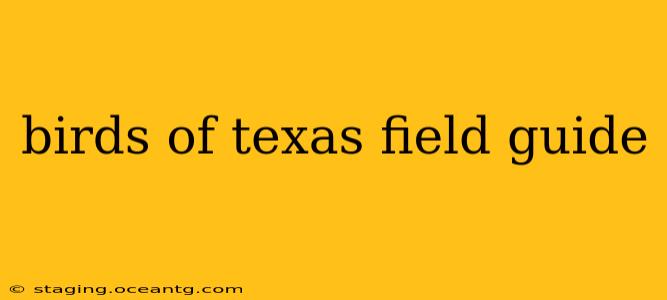Texas, with its diverse habitats ranging from arid deserts to lush forests and expansive coastlines, boasts an incredible array of bird species. This guide provides an overview of key aspects to consider when birdwatching in Texas, helping you identify the feathered friends you encounter. Whether you're a seasoned birder or just beginning your avian adventures, this guide will enhance your experience.
What are the most common birds in Texas?
Some of the most common birds you'll encounter across various regions of Texas include the Northern Cardinal (a vibrant red bird found practically everywhere), the Mourning Dove (easily identified by its soft cooing and grey-brown plumage), the American Robin (a familiar sight in lawns and parks), the House Sparrow (a ubiquitous, introduced species), and the Great Blue Heron (a majestic wading bird often found near water bodies). However, the specific common birds you see will depend on the habitat and season.
What is the best time of year to birdwatch in Texas?
The best time for birdwatching in Texas depends on your target species and desired experiences. Migration periods (spring and fall) offer the greatest diversity, as numerous species pass through the state. Spring, in particular, witnesses the arrival of many breeding birds showcasing vibrant plumage and active courtship behaviors. Summer offers opportunities to observe nesting birds and their young, while winter attracts wintering species from northern climates.
What are some good places to go birdwatching in Texas?
Texas offers a plethora of excellent birdwatching locations. Coastal areas like the Gulf Coast and Padre Island National Seashore attract shorebirds and waterfowl. The Hill Country boasts diverse habitats supporting a wide range of species. National parks like Big Bend National Park and Guadalupe Mountains National Park offer unique opportunities to see desert and high-elevation birds. Many state parks and wildlife refuges also provide exceptional birdwatching experiences, with well-maintained trails and visitor centers. Remember to check the specific locations for current opening hours and any necessary permits.
What kind of binoculars do I need for birdwatching in Texas?
Choosing binoculars depends on your budget and experience. For beginners, a pair of 8x42 binoculars offers a good balance of magnification and field of view. These specifications are widely considered ideal for general birdwatching, providing a comfortable viewing experience without being too bulky. However, experienced birders may prefer higher magnification for observing distant birds or specialized features like image stabilization. Research different brands and models to find the best fit for your needs and preferences.
What are some tips for identifying birds in Texas?
Bird identification requires careful observation. Start by noting the bird's size and shape. Pay close attention to its plumage—the colors, patterns, and markings on its feathers. Observe its behavior: how it flies, forages, and interacts with its surroundings. Listening to its calls and songs is crucial, as they are distinctive features for many species. Using a field guide specific to Texas birds will aid significantly in your identification efforts. Consider joining local birding clubs or guided birdwatching tours to learn from experienced birders.
What are some common mistakes beginner bird watchers make?
A common mistake is focusing too much on visual identification alone and neglecting the bird's sounds. Another frequent error is failing to note the habitat where the bird was observed. Similarly, neglecting to note the bird's behavior can limit identification accuracy. Finally, insufficient patience can lead to missed opportunities—birds are often shy and require some time for observation.
This guide provides a foundation for your birdwatching adventures in Texas. Remember to respect wildlife, adhere to responsible birding practices, and always leave the environment as you found it. Happy birding!
